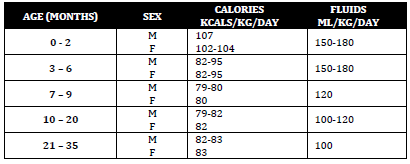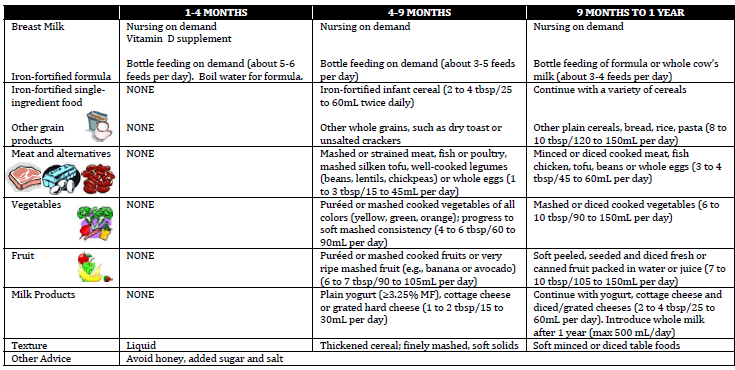Do you want BuboFlash to help you learning these things? Or do you want to add or correct something? Click here to log in or create user.
Nutrition
#has-images #ir #peds
- NUTRITION
- Infant feeding (30cc/1oz): breast (20kcal/oz, 0.67kcal/cc), AVG need (100kcal/kg/d)
- For a 9mo, select which foods can be introduced at this age? What are the normal feeding stages for a child?
- 0-6mo: breast milk or formula, 2-4oz (60-120ml) per feed, 8-12 feeds/day, 20-25min per feed
- 6-8mo: solid food introduction – do not delay beyond 9 mo
- 2 to 3 new foods/wk with few days in between (monitoring allergies)
- Suggested order: meat/alternatives/iron enriched cereal (rice cereal is least allergenic)àpureed vegetablesàfruit
- Breast milk/formula (6-8oz, 3-5/day) + infant cereal/biscuit/vege/fruit/meat/beans
- 8-12 mo: finger foods and switch to homogenized (3%) milk (9-12mo); breast/formula (6-8oz, 3-4/day) + cheese/yogurt, bread/pasta, infant cereal, veg/fruit, meat/beans
- Foods to avoid: honey (risk of botulism), added sugar/salt, juice (not nutritious, too much sugar), anything that is a choking hazard (chunks, round foods like grapes)
- >12mo: avoid excessive milk (i.e. <16 oz/d)
- Wt often falters before length (if length ↓, chr)
- Feeding milestones
- 0-4mo: root, suck, swallow
- 6mo: holds bottle/cup
- 8-12mo: finger feed, chew
- 12-18mo: uses cup, spoon
- 18-24mo: likes eating w/ hands
- 2-5y: food jags (fixated on few foods)
- 4-5y: knife, fork, good self-eater
Composition of Human Milk
• Colostrum
o Energy value
o Increased sodium, potassium, chloride
o Increased protein, fat‐soluble vitamins, minerals
o High level of antibodies
o Facilitates passage of meconium and establishment of Lactobacillus
bifidus flora in infant’s gut
• Mature Milk
o Energy value (0.67 kcal/mL)
o Fat (mainly triglycerides)
o Carbohydrates (mainly lactose)
o Protein (Whey>Casein)
o Vitamins/Minerals (except Vitamin D)
• Infants
o Maternal‐infant bonding
o Composition – digestible macronutrients
o Protection against infections (AOM, RSV infection, diarrhea)
o Passive immunity (macrophages, lymphocytes (IgA), lactoferrin,
lysozyme)
o Decreased incidence of SIDS
o Decreased allergies/atopy
• Maternal
o Decreased postpartum bleeding & faster uterine involution
o Lactational amenorrhea and delayed resumption of ovulation
o Earlier return to pre‐pregnancy weight
o Improved bone remineralization postpartum (and decreased hip
fracture in postmenopausal period)
o Decreased cost
o Ready availability without prep time
Contraindications to Breastfeeding
• Medical Disorders
o Baby: Galactosemia
‐ Absent liver enzyme galactose‐1‐phosphate uridyltransferase
‐ Unable to metabolize galactose, lactose (glucose + galactose)
‐ Without galactose restriction, leads to liver failure and mental
retardation
• Infections
o Mom: HIV, Human lymphotrophic virus (HTLV‐1 or HTLV‐2),
herpetic lesions on breast, active untreated TB
• Medications (www.motherrisk.org)
o Chemotherapy, immunosuppressants, lithium, ergot alkaloids,
radiopharmaceuticals, bromocriptine, iodides
Supplements Required When Breastfeeding
• Vitamin D
o Supplemental dosage: 400 IU/d
o Side effects w/out supplementation: Rickets/hypocalcemic seizure
37
Markers of Successful Breastfeeding
• ≤7% weight loss in first few days after birth
• Return to birth weight by at least 2 weeks
• 20‐30g per day weight gain during first 3 postnatal months
• Lactation established in mother by 4 days after birth
• ≥ 8 breastfeeding events Q24H
• Baby is latching onto breast easily
• 3‐6 stools/day and 4‐6 voids/day by 5‐7 days of age
Infant Formulas
Syllabus: Martinez at el. Infant Formulas. Pediatrics in Review. 2011;32(50):179.
The following is a list of different formulas available. This is just a sample;
there are many other brands and formulas available.
Cow’s milk based formulas
• Enfamil A+ with iron / Similac Advanced with iron – term infants if not
breastfeeding (low iron formulas should not be used)
• Goodstart/ Enfamil A+ for Babies Who Spit Up – can be used in infants
with delayed gastric emptying, GERD
• Enfalac Lactose Free – for infants who are lactose intolerant (rare)
• Different formulations: ready to feed; concentrated; powder
• Standard is 0.67kcal/ml
SoyBased
• Isomil / Enfalac Prosobee – should not be used in premature infants or
concern about cow’s milk protein allergy because of cross‐reactivity
between cow’s milk protein and soy
Therapeutic
• Nutramigen A+/Alimentum (partially hydrolyzed)
• Neocate/Puramino (amino‐acid based)
• Portagen/Pregestimal – (for infants with fat malabsorption – typically
if chylothorax post‐cardiac surgery)
Feeding Milestones

Calorie and Fluid Requirements
Applies to healthy, term infants. Infants recovering from acute
malnutrition or serious illnesses may need specialized feeding.

Feeding Requirements

Feeding Recommendations
Breastfeeding
• Exclusively for 6 months and for up to 2 years or beyond (as long as
mother and child want to continue)
AGE SKILLS
04
months root, suck, swallow
6 months holds bottle/cup
812
months finger feed, chew
1218
months uses cup, spoon
1824
months likes eating with hands
25
years food jags (fixated on a few foods)
45
years knife, fork, good self‐eater
AGE (MONTHS) SEX
CALORIES
KCALS/KG/DAY
FLUIDS
ML/KG/DAY
0 2
M
F
107
102‐104 150‐180
3 – 6 M
F
82‐95
82‐95 150‐180
7 – 9 M
F
79‐80
80 120
10 – 20 M
F
79‐82
82 100‐120
21 – 35 M
F
82‐83
83 100
39
Food Introduction
• Begin introducing foods at 6 months
• Iron‐rich are recommended as the first foods to introduce
• Gradually increase the number of foods and times/day offered while
continuing to breastfeed
• After introducing iron rich foods, all other foods (except milk & honey)
can be introduced in a variety of textures
• Homogenized cow milk can be introduced after 9‐12 months and
transitioned to family milk after 2 years old. 500 mL/day provides
sufficient vitamin D for bone health. Milk intake >750 mL may lead to
iron deficiency anemia.
• Honey should be avoided until 1 year of age because of the risk of
botulism
Allergenic foods
In the past, parents were advised to delay the introduction of allergenic
food into their child’s diet. Now, allergenic foods are introduced like any
other food. If there is concern, counsel the parent to wait 2 days between
introduction of an allergenic food and another food. If a reaction is to
occur, it will occur over those 48 hours. There is emerging data to support
that the early introduction of common allergens, such as peanuts, may
actually help prevent allergies.
Food textures
Before 2014 Health Canada recommended babies be introduced to pureed
foods. Now parents are encouraged to introduce their baby to a variety of
textures. Delaying the introduction of lumpy foods beyond 9 months has
been found to be associated with feeding difficulties and lower intake of
fruits and vegetables later in life. Caregivers should still avoid hard, small
and round, or smooth and sticky foods as these may causes aspiration and
choking.
Toss the Sippy Cup
Guidelines now encourage a child to start using an open cup starting at six
months to encourage mature drinking skills. These should be used with
assistance and small amounts of liquid to start. The sippy cup is associated
with prolonged bottle feeding which is associated with increased calorie
intake, childhood obesity, and caries.
Feeding Guidelines

Dental Care & Dental Milestones
• Children <3 years should have their teeth/gums brushed by an adult using a toothbrush moistened only with water
• If increased risk of tooth decay (non‐fluordinated water supply, visible tooth defect, regularly consumes sugary drinks/snacks between
meals, teeth brushed <1x/day, etc), use a rice sized amount of fluoridated toothpaste. An excessive swallowing of toothpaste by young
children may result in dental fluorosis.
• Children 3‐6 years should be assisted to brush their teeth using a pea sized amount of fluoridated toothpaste
• When the child can write their name in cursive, they can do a good job brushing their own teeth
Breast feeding: benefits ABCDEFGH:
· Infant:
Allergic condition reduced
Best food for infant
Close relationship with mother
Development of IQ, jaws, mouth
· Mother:
Econmical
Fitness: quick return to pre-pregnancy body shape
Guards against cancer: breast, ovary, uterus
Hemorrhage (postpartum) reduced
Infant nutrition
Breastfeeding - advantages
Mnemonic: PACES
P Psychological satisfaction
A Anti-infective property/Atopic disorders risk .
C Convenient
E Expenseless, ie free
S Stimulates growth and development
Breastfeeding - disadvantages
Mnemonic: KIDS
K vitamin K deficiency in breast-milk
I Infection transmission risk eg HIV
D Drugs excreted in milk
S Stressful and tiring for mother
Breast feeding: contraindicated drugs
BREAST:
Bromocriptine/ Benzodiazepines
Radioactive isotopes/ Rizatriptan
Ergotamine/ Ethosuximide
Amiodarone/ Amphetamines
Stimulant laxatives/ Sex hormones
Tetracycline/ Tretinoin
If you want to change selection, open original toplevel document below and click on "Move attachment"
Summary
| status | not read | reprioritisations | ||
|---|---|---|---|---|
| last reprioritisation on | suggested re-reading day | |||
| started reading on | finished reading on |
Details
Discussion
Do you want to join discussion? Click here to log in or create user.